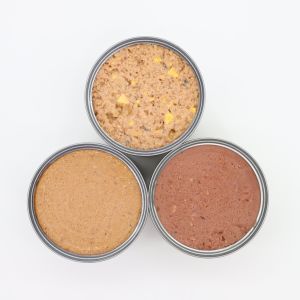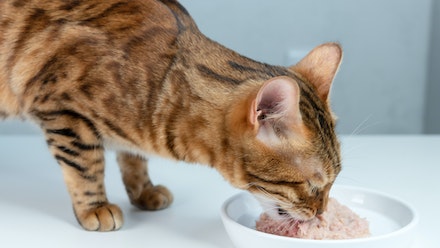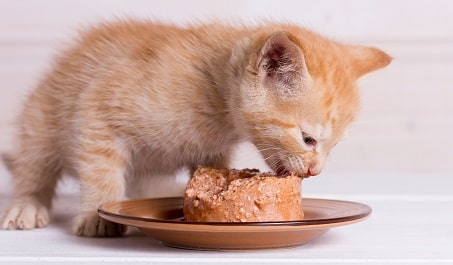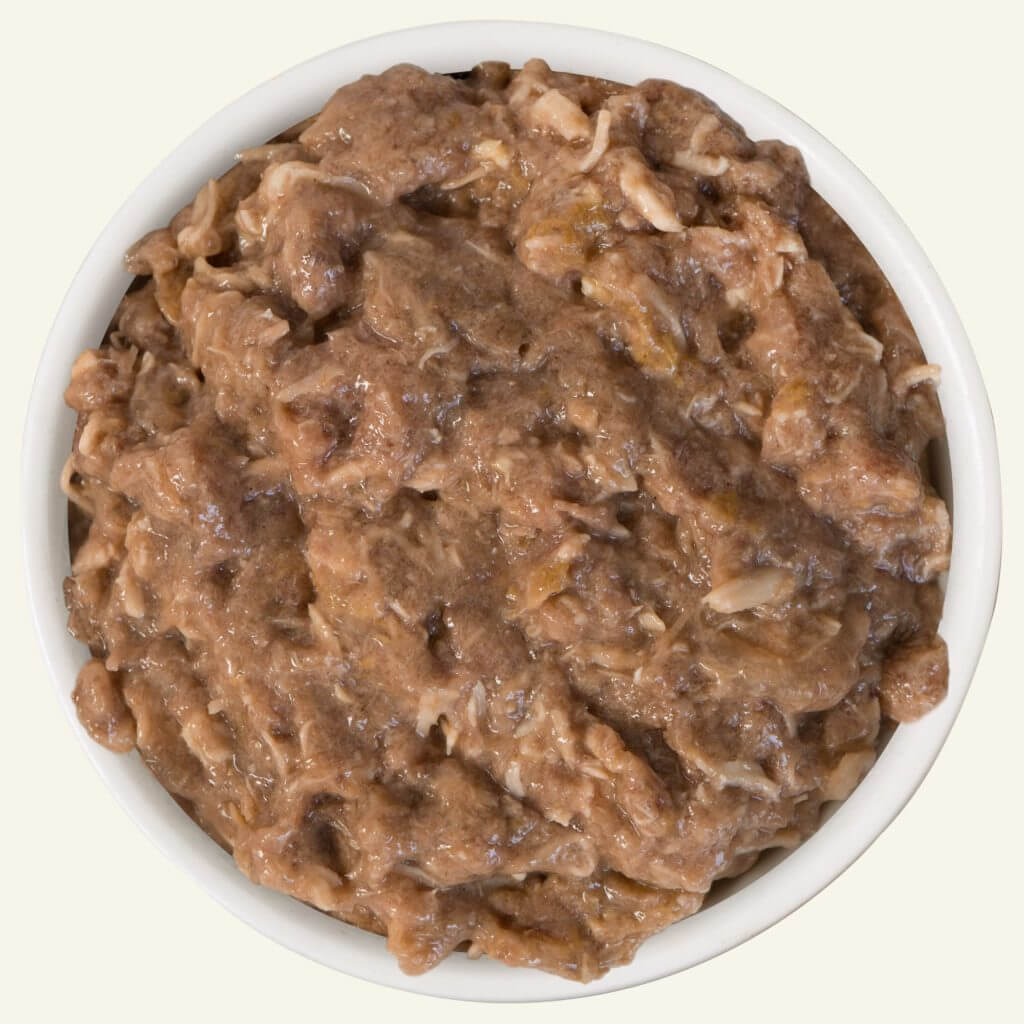There are two broad classifications of cat food: dry and wet.
The dry food is typically made up of kibble, which is a mix of cereals, meat, and other ingredients that have been extruded and shaped into bite-size pieces.
Wet or canned food contains higher moisture content and often looks more like human food.
Dry food is not only cheaper but also easier to handle than wet food.
However, wet food is better for cats because it more closely resembles their natural diet and also because it is easier to digest.
If you are used to feeding your cat dry food and then he develops digestive issues, your vet may recommend that you feed them with pate cat food.
(And no, Pate is not a play on the word pet).
What Is Pate Cat Food?
Pate is a French word that literally translates to paste.
As such, Pate cat food is a type of wet cat food that is in the form of a paste or thick puree.
The paste is typically made from ground meat, organs, and bones. It can also contain other ingredients like vegetables, fruits, and grains.
Pate has a thick gravy-like consistency and it can vary from a creamier to a firmer consistency depending on how it is formulated.
This consistency makes it a good food for serving as-is but it can also be mixed in water to be an ingredient in making treats or added to the broth.
As we have seen, Pate just means paste, so the word is loosely used to refer to any pureed foods.
As such, do not assume that any food labeled pate is for cats—some are for dogs and you can also find Pate on a menu of your favorite eatery.
Be sure to crosscheck to ensure the canned pate food is meant for cats before you buy it.
Also, when buying Pate cat food, check the can to make sure you are getting the one that is appropriate for your kitty.
That’s because Pate has specially formulated cat foods for kittens, adults, and senior cats.
What Is The Difference Between Pate, Minced, Flaked, And Gravy Cat Food?

The main difference between pate, minced, flaked, and gravy cat food is the texture.
Pate cat food has a smooth, thick, and creamy texture.
Minced cat food is primarily made from minced meat and usually has a chunkier texture.
Flaked cat food is made from flaked meat (flat or chipped) and has a softer, flakier texture.
Some manufacturers want to offer you the best of both worlds by combining a couple of the varieties in one can.
For instance, chunks in gravy describe a specially formulated cat food that has the characteristic smooth texture of Pate but also has some chunks of meat in it.
All of these types of wet food can be a good choice for cats, depending on their preferences or nutritional requirements.
Some cats prefer the smoother texture while others may prefer the chunks in gravy or flaked varieties.
If you are unsure, you can test the different varieties until you find one that your cat likes.
Benefits of Pate Cat Food

Pate cat food has lots of benefits that make it a good choice for your cat.
- High Moisture Content: Pate is packed with moisture, which is great for cats that don’t drink enough water.
- Easy to Digest: Pate is easy to digest, which can be helpful for cats with digestive issues.
- Simple Ingredients: Pate is often made with simple ingredients, which can be a good choice for cats that are picky eaters or have allergies.
- High Protein Content: Pate is generally higher in protein than other types of wet food, making it a good choice for active cats or kittens.
Demerits of Pate Cat Food
Pate cat food also has some drawbacks that you should be aware of:
- May Contain Fillers: Some Pate cat foods may contain fillers like corn or wheat, which can be unhealthy for cats.
- High-Fat Content: Pate is often high in fat, which can lead to weight gain if your cat eats too much of it.
- High-Calorie Content: Pate is also high in calories, so it’s important to feed your cat the recommended amount and not overdo it.
Pate cat food can be a good choice for your cat, but be sure to choose quality food that does not contain fillers or artificial ingredients.
Also, be sure to monitor your cat’s intake to avoid overfeeding and weight gain.
Related Post: Homemade Cat Foods for Weight Gain
Is Pate Good For Kittens?

Pate is a good choice for kittens because it is packed with moisture and easy to digest.
In fact, Pate cat food is recommended whenever you are weaning kittens.
The soft texture coupled with the high nutrition is just what kittens need to develop into healthy young adults.
Kittens need high levels of protein to support their growth and development, and Pate cat food generally has higher protein content than other types of wet food.
However, because Pate is high in fat and calories, it’s important to feed your kitten the recommended amount and not overdo it.
If you are unsure how much to feed your kitten, talk to your veterinarian.
How Much Pate Should I Feed My Cat?
Cats have different nutritional needs depending on their age, weight, and activity level.
So, the first step in determining how much Pate you should feed your kitty is having them evaluated by the vet.
The goal of this evaluation is to find out the weight of the cat and thereby determine the required daily calorie intake. You can also use a pet calorie calculator to get an estimate.
Once you have an idea of the calorie requirements, the next step is to check the cat food label. This will tell you how many calories are in each serving.
For example, if a 5-ounce can of pate cat food contains 200 calories and the recommended daily calorie intake for your kitty is 400 calories, then you would feed them half a can per day.
Just like with any other food, it’s important to start slowly when introducing pate into your cat’s diet.
Start with a small amount and gradually increase it over time. This will give your cat’s digestive system time to adjust to the new food.
It will also allow you to observe and see how your cat is responding to the food.
Can Cats Eat Pate Every Day?
Vets recommend feeding your cat wet food every day because of the moisture content among other benefits.
For this reason, it is very much okay to feed your cat Pate every day because it has all the required nutrients.
Additionally, Pate cat food has fewer carbohydrates than dry foods which means your cat will have a better chance of avoiding obesity and other health problems that come with high carbohydrate diets.
However, if you are feeding your cat pate every day, be sure to monitor their intake to avoid overfeeding by following the directions on the package or as advised by your vet.
Quick Tips for Getting the Most Out Of Pate Cat Food
When feeding your cat on pate, there are a few things you can do to make sure they’re getting the most out of it:
- Choose Quality Food: When choosing pate cat food, be sure to choose a quality product that does not contain fillers or artificial ingredients.
- Monitor Intake: Be sure to monitor your cat’s intake to avoid overfeeding. Pate is high in fat and calories, so it’s important to feed your cat the recommended amount.
- Start Slowly: When introducing pate into your cat’s diet, start with a small amount and gradually increase it over time. This will give your cat’s digestive system time to adjust to the new food.
- Add Some Warm Water: If the Pate is too firm, add some warm water and mix it with a fork to make a smoother consistency. Some cats prefer this texture and it’s also easier on their digestive system.
- Add Some Toppers: To make the pate more enticing, try adding some toppers like shredded cheese or chopped-up chicken. You can also add a bit of wet food topper to dry food to make a yummy meal for your cat.
Parting Thoughts
In conclusion, Pate cat food is a good choice for your cat because it is packed with moisture and easy to digest.
Kittens also need high levels of protein to support their growth and development, and Pate cat food generally has higher protein content than other types of wet food.
However, because Pate is high in fat and calories, it’s important not to overdo it.

Hi! I am Eleanor Price. I started this website after my cat, Louie, almost died from a case of botulism (a type of food poisoning often caused by bacteria that grow on food items). Turned out that my cat’s diet was the problem. I have made it my duty to provide the best information and recommendations about everything cat lovers need to know about their felines’ health and wellbeing. My goal is to find the most informative content on anything feline-related and share it with fellow hardworking kitty lovers.

